Forfeiture enables a landlord to end a lease if the tenant fails to pay the rent. Most commercial leases contain an express right to forfeit if the rent has remained unpaid for a specified period.
A common pitfall for landlords contemplating forfeiture is inadvertently waiving their rights. Simply put, a landlord must not do anything to affirm the lease after the breach. This includes demanding or accepting rent.
A landlord can exercise their right to forfeiture through peaceable re-entry or Court proceedings. Peaceable re-entry involves taking back physical possession of the premises, most commonly by changing the locks. It is quicker and cheaper than Court proceedings, which are more appropriate if the arrears are disputed.
Forfeiture offers a fast, cost-effective solution to landlords wishing to rid themselves of a problem tenant, or relet the premises in a buoyant market. A key drawback, however, is that it does not realise the unpaid rent. Further, if the landlord cannot secure a new tenant, they will lose rental income and be liable to pay any expenses until the premises are relet.
Commercial rent arrears recovery (CRAR)
CRAR is a statutory right allowing commercial landlords to recover outstanding rent through the seizure and sale of the tenant’s goods.
CRAR can only be used once a sum equivalent to 7 days’ rent is outstanding. The landlord must give the tenant 7 days’ notice of their intention to use CRAR which, in itself, can encourage a tenant to make good the arrears. The landlord can subsequently instruct Certificated Enforcement Agents to seize goods to sell at auction.
CRAR can be an efficient way of collecting rent arrears, particularly if a tenant owns numerous high value goods. Unlike forfeiture, the tenant remains in the property.
A major downside of CRAR is that it prejudices the landlord’s forfeiture rights. Various costs – such as those of the auctioneer – are taken from the sale proceeds first, so there may be insufficient funds to cover the arrears. Further, the 7-day notice requirement can result in a tenant ‘hiding’ assets.
Withdrawing the money owed from the rent deposit
If the tenant paid a deposit, the landlord might be able to draw down on it to cover the arrears, if the Rent Deposit deed allows.
This option is useful if the tenant’s cash flow difficulties are temporary. However, if the tenant is unable to pay the rent on an ongoing basis and is likely to leave the property, the landlord should consider whether it might be more sensible to retain the deposit for other expenses such as a dilapidations claim. Further, this option can result in a waiver of the landlord’s forfeiture rights.
Payment Agreement
If arrears are due to short term financial issues, a Payment Agreement can offer a sensible solution. Under this option, the landlord agrees to accept payment of the arrears in instalments. The agreement will detail the sums to be paid by the tenant and should expressly reserve the landlord’s right to forfeiture.
Payment Agreements preserve the parties’ relationship and avoid the premises becoming vacant. The recovery will, however, be piecemeal and the agreement might, in some circumstances, prejudice the landlord’s forfeiture rights.
Debt recovery proceedings
The landlord can issue proceedings seeking a Court Order that the tenant pays the arrears together with any interest and costs. Litigation is notoriously expensive and time consuming, so it is often a last resort. However, it may be unavoidable if the tenant disputes the arrears or when all other recovery methods have failed.
Once a landlord has obtained Judgment, they need to enforce it to recover the arrears. This might involve taking a charge over the tenant’s property, instructing bailiffs or applying for an order for payment direct from the tenant’s a bank account.
Statutory demand
If the arrears are undisputed, the landlord can serve a ‘statutory demand’ as a precursor to insolvency proceedings.
The arrears must be cleared within 21 days of service of a statutory demand. If they are not, the demand can be relied upon as evidence of the tenant’s inability to pay their debts, and insolvency proceedings can then be commenced. A landlord can only serve a statutory demand if the arrears amount to at least £750 in the case of a corporate tenant, or £5,000 for an individual.
Sometimes, the mere threat of insolvency focuses a tenant’s mind and encourages payment. However, a landlord must be certain that the debt is liquidated and undisputed before serving a demand; otherwise, they may be liable for the tenant’s legal costs in disputing the demand. Further, if the tenant has numerous creditors, the landlord might not recover the total arrears on their insolvency.
Winding Up Petition
A landlord can present a winding up petition asking for a company tenant to be liquidated on the basis that it cannot pay its debts. The impact of a winding up petition can be catastrophic. The tenant’s bank accounts will be frozen, and the petition will be made public, often leading to the loss of customers and suppliers.
The landlord must prove that the tenant is unable to pay its debts. If they cannot do so, the petition will fail, and the landlord will be ordered to pay the tenant’s legal costs. In practice, therefore, a statutory demand is often served before a winding up petition is presented. If the tenant has other creditors, the rent arrears might not be fully cleared.
Key advantages and disadvantages of each option
|
|
Advantages
|
Disadvantages
|
|
Forfeiture
|
Ends the lease and landlord can relet the premises
Fast and cost effective
|
Does not realise the arrears
May lead to vacant premises
|
|
CRAR
|
Fast and cost effective if goods readily available
Tenant remains in property
|
Tenant may hide assets
Waives right to forfeiture
Value of goods may not cover arrears
|
|
Rent deposit draw down
|
Quick and easy
Useful if non-payment is one-off
Tenant remains in property
|
May result in a lack of funds for other eventualities
Could waive forfeiture right
|
|
Payment by instalments
|
Preserves relationship
Tenant remains in property
|
Piecemeal recovery
May prejudice forfeiture rights
|
|
Debt recovery
proceedings
|
Resolves any dispute
May be only option if others have failed
|
Expensive and time consuming
Landlord will need to enforce Judgment
|
|
Statutory demand
|
Quick and easy
Often prompts payment
|
Debt must be undisputed
Landlord might not recover full arrears
|
|
Winding-up petition
|
Often prompts payment
|
Debt must be undisputed
Landlord might not recover full arrears
|
Summary
A commercial landlord has numerous options through which to recover rent arrears. Each option has specific advantages and disadvantages, and the landlord must decide which is the most appropriate. Forfeiture might be desirable in a buoyant market where the landlord wishes to take back the premises and relet them. A method like payment by instalments, on the other hand, will preserve the relationship and enable a landlord to recover the full arrears, albeit over time. A landlord should carefully consider the potential ramifications of each option before they proceed, particularly with regard to their forfeiture rights.
Want to comment on this story? Our focus is on providing a platform for you to share your insights and views and we welcome contributions.
If any post is considered to victimise, harass, degrade or intimidate an individual or group of individuals, then the post may be deleted and the individual immediately banned from posting in future.
Please help us by reporting comments you consider to be unduly offensive so we can review and take action if necessary. Thank you.







.png)







.png)





Join the conversation
Jump to latest comment and add your reply
Reenter during day light hours change the locks and place a large notice in the window, I've done this a few times, and it works, can be really amusing as well
Please login to comment